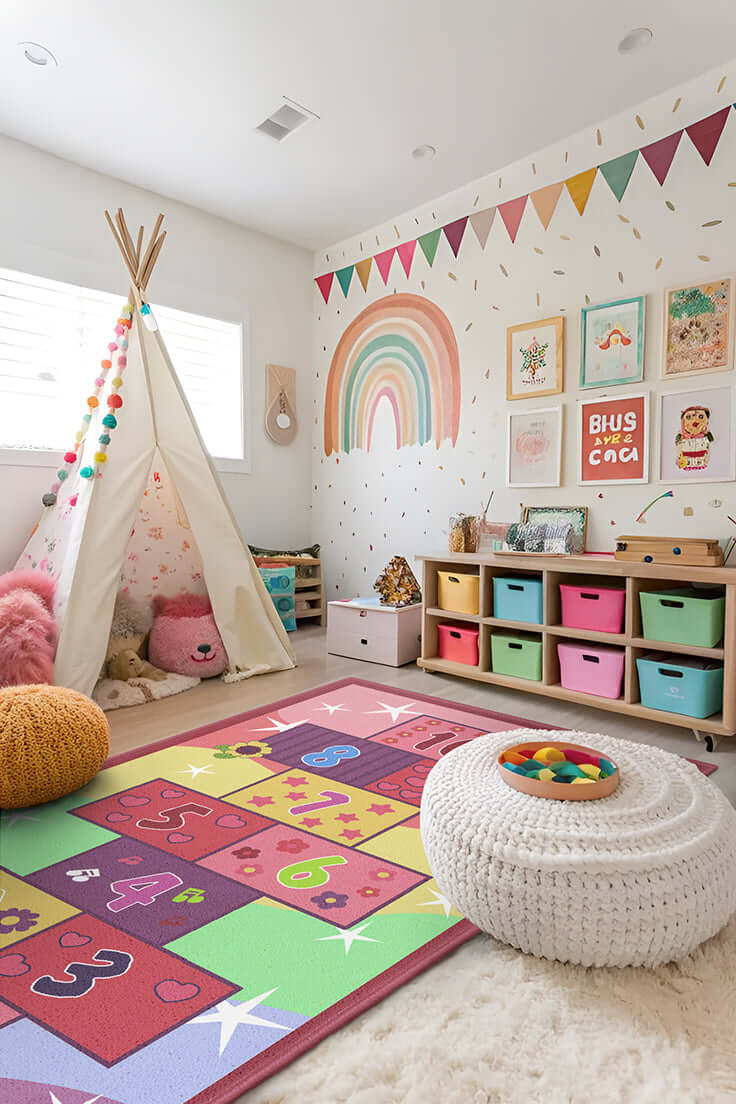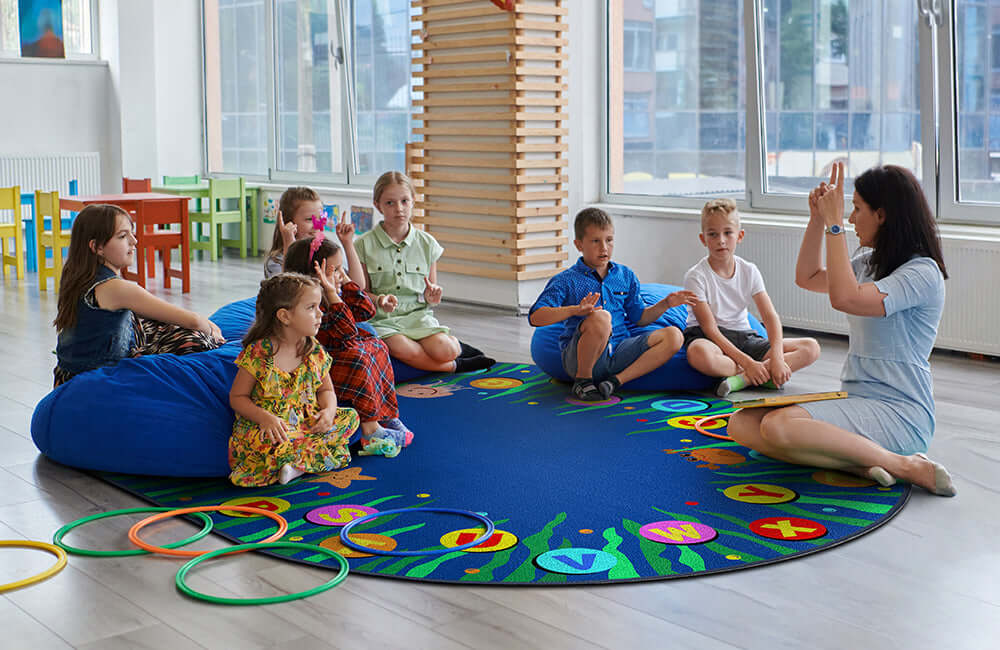The Rise of Interactive Classroom Technology
Modern educational spaces demand more than traditional teaching tools. Interactive classroom rugs now feature embedded sensors, LED lighting systems, and pressure-sensitive surfaces that respond to student movement and touch.
This technology transforms passive floor space into dynamic learning platforms where students can literally step into their lessons.
According to Educational Technology & Society research, interactive floor systems increase student engagement rates by up to 75% compared to traditional teaching methods.
The kinesthetic learning opportunities provided by technology-enhanced rugs address multiple learning styles simultaneously.
Smart Rug Features Revolutionizing Learning
Pressure-Sensitive Learning Surfaces
Advanced classroom rugs now incorporate pressure-mapping technology that detects student positions and movements.
These systems can track group formations, monitor activity levels, and even assess participation patterns during Seating Rugs support collaborative exercises.
Teachers receive real-time data about student engagement through connected dashboard applications.
LED Integration and Visual Feedback
Embedded LED strips transform ordinary rugs into LED designs on Colorful Classroom Rugs support game-based learning, mathematical grids, and geographical maps.
Students can solve problems by physically moving to different rug sections, with correct answers triggering visual rewards through coordinated light displays.
Wireless Connectivity and App Integration
Modern educational technology tools connect directly to classroom tablets, smartboards, and learning management systems.
Teachers can instantly customize rug displays, create interactive lessons, and track student progress through dedicated mobile applications.
Benefits of Technology-Enhanced Classroom Rugs
Increased Student Engagement
Technology integration naturally draws student attention and maintains focus throughout lessons.
Interactive elements encourage active participation, transforming traditionally passive learners into engaged participants who physically interact with educational content.
Data-Driven Learning Insights
Smart rugs collect valuable analytics about student behavior, learning patterns, and engagement levels.
This data helps teachers identify struggling students, optimize lesson pacing, and adapt instruction methods to meet diverse learning needs.
Multi-Sensory Learning Experiences
Soft visual tones found in Pastel Classroom Rugs help reduce visual overstimulation while maintaining engagement.
Combining tactile carpet surfaces with visual technology creates rich sensory experiences that support various learning preferences.
Students with different abilities can access content through multiple channels simultaneously.
Implementation Strategies for Tech-Integrated Rugs
Gradual Technology Adoption
Schools can implement smart rug technology progressively, starting with basic interactive features and expanding capabilities over time.
This approach allows educators to adapt to new tools while managing budget constraints effectively.
Professional Development Requirements
Successful technology integration requires comprehensive teacher training.
Educators need support understanding both the technical aspects and pedagogical applications of smart classroom rugs to maximize their educational potential.
Infrastructure Considerations
Modern classroom rugs require robust wireless networks, adequate power supplies, and compatible device ecosystems.
Schools must evaluate their current classroom infrastructure before implementing advanced interactive flooring solutions.
Subject-Specific Applications
Mathematics and STEM Education
Large Classroom Rugs can display number lines, coordinate planes, and geometric shapes that students manipulate through physical movement.
Complex mathematical concepts become tangible when students can walk through problems and visualize solutions on responsive floor surfaces.
Language Arts and Literacy
Word games, spelling activities, and story mapping exercises come alive on technology-enhanced rugs.
Students can physically arrange story elements, hunt for vocabulary words, and participate in interactive Reading Rugs comprehension activities.
Social Studies and Geography
Digital maps projected onto smart rugs allow students to explore historical events, trace migration patterns, and understand geographical relationships through immersive experiences that traditional textbooks cannot provide.
Cost-Benefit Analysis of Smart Classroom Rugs
Initial Investment Considerations
Technology-integrated rugs require higher upfront costs compared to traditional options, but schools report significant returns through improved test scores, increased attendance, and enhanced student satisfaction.
Many districts find grant funding specifically for innovative educational technology projects.
Long-Term Value Proposition
Smart rugs typically offer 5-7 year lifespans with regular software updates extending functionality.
The versatility of programmable systems means one rug can serve multiple subjects and grade levels, maximizing educational value per dollar invested.
Maintenance and Technical Support
Routine Care Requirements
Technology-enhanced rugs need specialized cleaning protocols to protect embedded electronics while maintaining hygiene standards.
Most manufacturers provide detailed maintenance guidelines and offer professional cleaning services designed specifically for interactive educational flooring.
Software Updates and Troubleshooting
Regular software updates ensure optimal performance and access to new educational content.
Schools should establish relationships with technical support teams and train on-site staff to handle basic troubleshooting procedures.
Future Trends in Educational Flooring Technology
Artificial Intelligence Integration
Next-generation classroom rugs will incorporate AI algorithms that adapt to individual student learning patterns, automatically adjusting difficulty levels and providing personalized feedback during activities.
Augmented Reality Compatibility
Emerging AR technologies will overlay digital information onto Boho Classroom Rugs creating immersive learning environments that blend real and virtual worlds with style and comfort.
Sustainability and Eco-Friendly Materials
Future sustainable classroom design will prioritize environmentally responsible materials in smart rug construction, incorporating recycled components and energy-efficient technologies.
Addressing Common Implementation Challenges
Budget Constraints and Funding Solutions
Schools can explore various funding options including federal education grants, corporate sponsorships, and crowdfunding campaigns specifically for innovative classroom technology.
Many manufacturers offer flexible payment plans and lease-to-own programs.
Teacher Resistance and Change Management
Successful implementation requires addressing educator concerns through hands-on demonstrations, peer testimonials, and gradual integration strategies that build confidence over time.
Measuring Success and ROI
Academic Performance Metrics
Schools track improvements in standardized test scores, classroom participation rates, and student retention of key concepts to measure the effectiveness of technology-enhanced learning environments.
Student Satisfaction and Engagement
Regular surveys and observational assessments help administrators understand how interactive rugs impact student motivation, classroom behavior, and overall learning satisfaction.
Conclusion
Technology integration in classroom rugs represents a significant leap forward in educational innovation.
These smart flooring solutions create dynamic, responsive learning environments that engage students in unprecedented ways while providing teachers with valuable data and versatile instructional tools.
As schools continue embracing digital transformation, interactive classroom rugs offer a unique opportunity to combine physical comfort with technological advancement.
The investment in smart Educational Rugs pay dividends through improved student outcomes, enhanced teacher effectiveness, and future-ready learning environments that prepare students for tomorrow's digital world.
The evolution from simple carpet squares to sophisticated interactive learning platforms demonstrates education's commitment to innovation and student success.
Schools ready to embrace this technology will find themselves at the forefront of educational excellence, creating memorable learning experiences that students will carry with them long after graduation.




Leave a comment
This site is protected by hCaptcha and the hCaptcha Privacy Policy and Terms of Service apply.